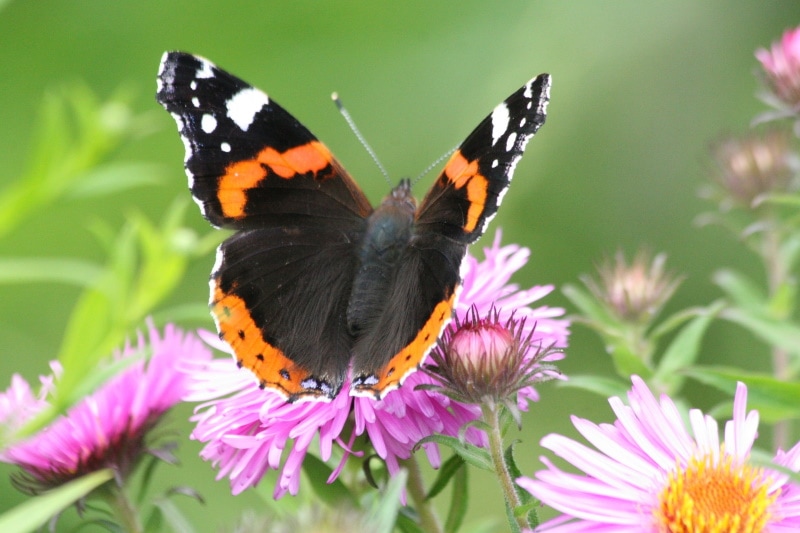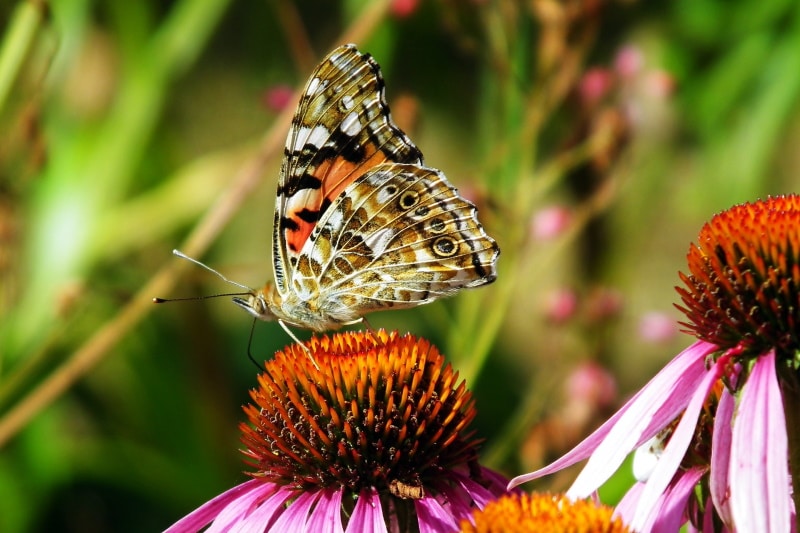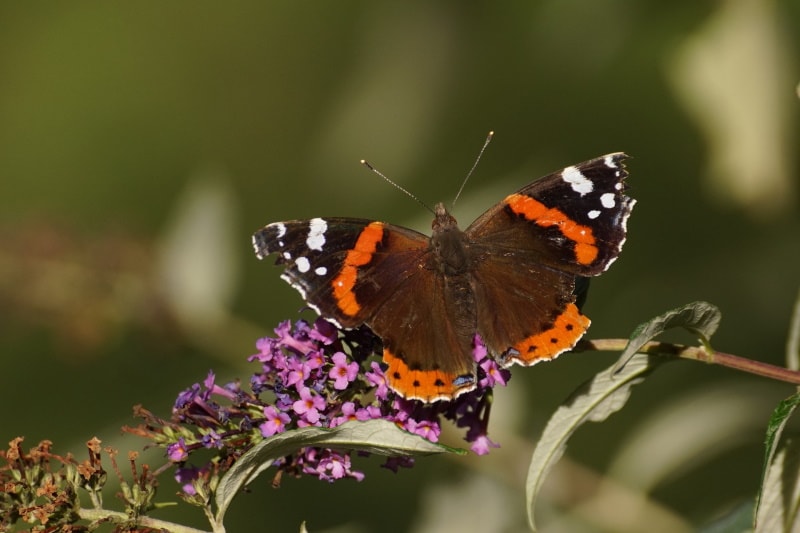4 Most Common Types of Butterflies in Oregon (With Pictures)
-
Pete Ortiz
- Last updated:

The West Coast has over 150 species of butterfly spread throughout Washington, California, and Oregon. While most of these winged wonders can be found in Oregon, some are more common than others.
Generally, the peak butterfly season in Oregon is summer. When exploring the outdoors and getting in touch with nature, it’s hard not to spot infinite numbers of colorfully-patterned wings fluttering through the air. Oregon offers different butterfly habitats, and some of the best places to spot these gorgeous creatures include the coastal range mountains and Cascade-Siskiyou National Monument.
Read on to learn more about the common types of butterflies in Oregon. We will outline their appearance and preferred habitat. Hopefully, you will also learn some tricks to make butterflies visit your garden and prolong their stay throughout the peak season.
The 4 Most Common Types of Butterflies in Oregon
1. Oregon Swallowtail

| Average wingspan | 2.5 to 4 inches |
| Peak Season | April and September |
| Adult’s Lifespan | 6 to 14 days |
The Oregon swallowtail is native to Oregon, Idaho, Washington, and south-central British Columbia and is an elegant and colorful butterfly. It is one of the most sought-after butterflies by collectors who target it for its eye-catching appearance.
On July 16, 1979, it earned the title of Oregon’s official insect.
- Appearance: During the caterpillar stage, the larva has black and yellow markings. The Oregon swallowtail pupa has a blackish-green or dull-hued chrysalis, and adults have elegant bright-colored wings. Their most notable feature is the concave spots with orange-red eyespots. Also, this butterfly is distinct in its forked hindwings. At their black base, beige and yellow markings make a pretty alluring pattern. The Oregon swallowtail also has a black-lined pattern that extends beyond the wings. This “tail” is more aesthetic than functional. When necessary, the butterfly can sacrifice its tail to escape a predator.
- Habitat: The Oregon swallowtail prefers living in the east of the Cascades. You can find it in the sagebrush- canyons at elevations below 4,000 feet. In Oregon, most sightings are along the Columbia River and its immediate tributaries.
2. Painted Lady

| Average wingspan | 1.5 to 2.8 inches |
| Peak Season | July through October |
| Adult’s Lifespan | 14 to 26 days |
The painted lady is a unique species with enchanting characteristics. The butterfly is also called the cosmopolitan butterfly because it inhabits all continents except Antarctica and Australia. Some also call it the thistle butterfly for its fondness of nectar from the thistle plant.
The painted lady’s unique characteristics include its flight speed of up to 30 miles per hour. The butterfly can also travel far, covering up to 100 miles daily. Also, the species has an unusual migration pattern that is not hinged on seasonal changes. While some believe the butterflies migrate based on climatic patterns, others believe they relocate because of overpopulation.
- Appearance: Painted lady caterpillars have black spiny bodies with white spots and a yellow stripe on the side. On the other hand, pupa chrysalis can be metallic green, bluish-white, or brown. The pupation stage lasts between 7 and 10 days. Adult painted lady butterflies have black-tipped forewings with white dots. The hindwings have black spots, and the upper wing is pale orange. The undersides have a pale hue with bright blue eyespots.
- Habitat: The painted lady butterflies have one of the broadest global distributions. In Oregon, you can find them in open gardens, dunes, and meadows where they can find nectar from plants like ironweed, cosmos, thistles, aster, or blazing stars.
3. Gray Hairstreak

| Average wingspan | 1 to 1.5inches |
| Peak Season | February to November |
| Adult’s Lifespan | 3 to 4 weeks |
Gray hairstreak butterflies are best known for their false head pattern. When perching, they keep their head down, and the false antennae (set of tiny hindwing tails) at the back of their wings point upward. They can escape without mortal wounds if predators attack their rear wings.
Distribution-wise, gray hairstreaks are pretty common in Oregon. While they are not as colorful as most butterflies within the state, they are a sight to behold, especially during peak seasons.
- Appearance: Gray hairstreak caterpillars have a bright green hue with a distinct line that runs from the head to the rear. The chrysalis during the pupa stage has a groundnut-like shape and shade. This stage lasts between 7 and 10 days. Adults have ash-gray wings with huge red spots on the borders. The hindwings are dark gray, although they appear faded during summer. Gray hairstreaks have a somewhat straight post-median line with a red-orange edge.
- Habitat: Gray hairstreaks can be found in most open fields across Oregon. They are also common in residential settings and disturbed lands that lack dense vegetation. You can attract the butterflies to your property by planting some of their favorite flower species like tick trefoil, winter cress, sweet white clover, or milkweed.
4. Red Admiral

| Average wingspan | 1.75 to 2.5 inches |
| Peak Season | Spring and summer |
| Adult’s Lifespan | Up to 10 months |
The red admiral was known as the “Red Admirable” during the 18th century. As the name suggests, it has striking aesthetics and is one of the easiest-to-identify butterfly species. The best part is that these gorgeous creatures are people-friendly and may perch on you. If a red admiral lands on you and you want it to leave, give it a gentle blow, and it will fly away.
Apart from North America, red admirals are also found in Central America, North Africa, Europe, Asia, and various other parts of the world. They are indigenous to temperate regions, although they can prolong their stay within an area if temperatures don’t drop too low during winter.
- Appearance: Red admiral caterpillars have black bodies with white or yellow speckles. Their chrysalises, when pupating, are black or bright scarlet. Adult red admirals have velvety black wings with orange-red bars on the forewings. You’ll also notice white spots at the tips. The hindwings have delicate orange-red fringes with tiny blue eye spots.
- Habitat: Red admirals are widespread in Oregon; you can find them in fields, parks, yards, seeps, and marshes. They frequent residential gardens, and you could find them basking in sunny spots after feeding on flowers. You can attract them to your property by placing a tray of rotting blackberries, plums, or apples in your garden.
Final Thoughts
Because of the diversity of butterflies in Oregon, you can spot different species in summer, spring, and fall. However, summer marks the best season for spotting and taking photos of these gorgeous insects because there’s a nice balance of various species. They are active during the day and bask with their wings outstretched or held upright over their bodies.
We hope you are now well-acquainted with some of the most common butterflies in Oregon. Have fun and be careful not to harm them and their habitats.
Featured Image Credit: Cornelia Gatz, Pixabay
Contents


